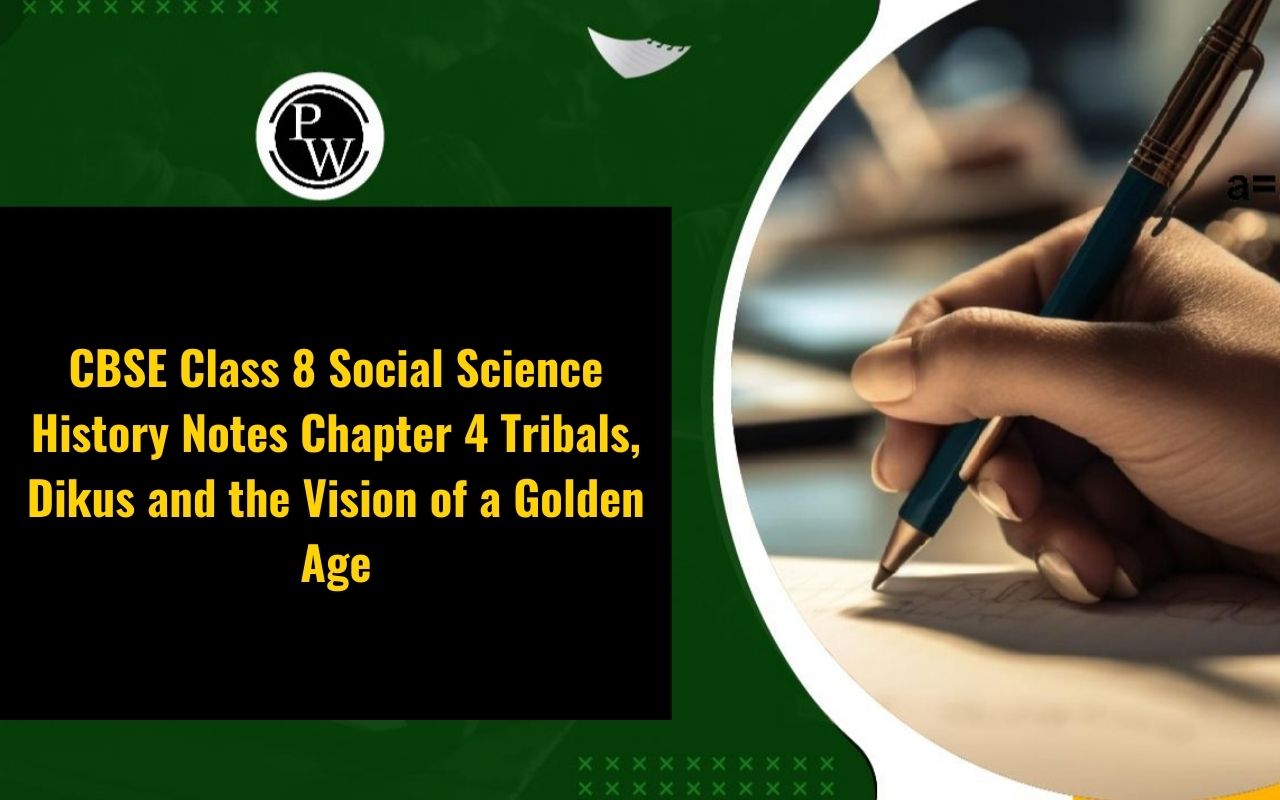

CBSE Class 8 Social Science History Notes Chapter 4: In this chapter, students will read some questions about the experiences and challenges faced by tribal communities.
This chapter focuses on the lives of tribal communities in India, focusing on their experiences with external influences and internal visions of progress. It explains how tribals referred to as "Dikus" by themselves faced challenges and disruptions due to colonial rule and the encroachment of outsiders. The chapter also highlights the various movements and aspirations for a better, self-reliant society envisioned by these communities amidst the changing socio-political landscape of India.CBSE Class 8 Social Science History Notes Chapter 4 Overview
These notes for CBSE Class 8 Social Science History Chapter 4 Tribals, Dikus, and the Vision of a Golden Age are prepared by subject experts from Physics Wallah. They provide a detailed overview of the key concepts and historical events discussed in the chapter. With precise explanations and accessible language, these notes are an invaluable resource for students to grasp the important aspects of the chapter effectively.CBSE Class 8 Social Science History Notes Chapter 4 PDF
The PDF for CBSE Class 8 Social Science History Chapter 4 Tribals, Dikus, and the Vision of a Golden Age is available below. Students can use this PDF to enhance their understanding of the historical issues faced by tribals, their interaction with outsiders and the changes imposed by colonial rule. To access and download the PDF click on the link provided below.CBSE Class 8 Social Science History Notes Chapter 4 PDF
CBSE Class 8 Social Science History Notes Chapter 4 Tribals, Dikus and the Vision of a Golden Age
Here we have provided CBSE Class 8 Social Science History Notes Chapter 4 Tribals, Dikus and the Vision of a Golden Age–Introduction
The customs and rituals of tribal societies often diverged significantly from the practices prescribed by Brahmanical traditions. Unlike the rigid caste-based structure prevalent in other parts of Indian society, tribal communities were typically organized around shared kinship ties rather than caste divisions. Despite this lack of caste hierarchy, there were still social and economic disparities within these tribes. These differences reflected a complex social fabric where traditional practices and internal hierarchies played a crucial role in shaping tribal life.How Did Tribal Groups Live?
By the nineteenth century, tribal groups in India engaged in a variety of livelihoods, each adapted to their environment and resources.Jhum Cultivators: Many tribal people practiced Jhum, or shifting cultivation, where they cleared small patches of forest land by cutting and burning vegetation to grow crops. After harvesting, they moved to new fields, allowing the old land to regenerate.
This method was prevalent in the hilly and forested regions of North-East and central India, where the forested terrain facilitated such cultivation practices.Hunters and Gatherers: Some tribes, such as the Khonds, relied on hunting and gathering for survival. They conducted collective hunts, divided the meat among themselves, and gathered fruits, roots, and forest produce.
Forests provided essential resources, including medicinal herbs and oil from seeds like sal and Mahua. When forest resources dwindled, tribal people often sought work as laborers and became dependent on traders and moneylenders, facing high interest rates on loans.Herders: Animal herding was another occupation, with many tribal groups practicing pastoralism. They moved their herds of cattle or sheep according to seasonal changes, adapting their movement patterns to ensure the welfare of their animals.
Settled Cultivators: Over time, some tribal groups transitioned to settled agriculture. For instance, the Mundas of Chottanagpur regarded land as communal property, with all clan members considered descendants of the original settlers.
British officials perceived settled tribal groups as more 'civilized' compared to their nomadic or shifting cultivation counterparts.A Closer Look
Tribal groups across India actively resisted the colonial changes imposed upon them, including new laws, restrictions on their traditional practices, increased taxes, and exploitation by traders and moneylenders.Birsa Munda: Born in the mid-1870s, Birsa Munda was inspired by the historical uprisings of his people and the sirdars urging revolt. His education in a local missionary school exposed him to ideas about reclaiming lost rights and spiritual beliefs.
Birsa's movement aimed to reform tribal society, advocating for the abandonment of alcohol, the cleaning of villages, and a rejection of witchcraft. He also envisioned a return to a golden age of prosperity and self-sufficiency for the Mundas. In 1895, Birsa mobilized his followers to revive their past glory and establish a Munda Raj, driven by the desire to expel missionaries, moneylenders, Hindu landlords, and the colonial government. He used traditional symbols and rhetoric to rally support, portraying the colonial rulers and exploiters as “Ravana” to be defeated. Birsa's death in 1900 from cholera marked the decline of the movement, but its impact was significant. It compelled the colonial government to enact protective laws for tribal lands and demonstrated the tribal people's resolve to challenge and protest against colonial injustices.Benefits of CBSE Class 8 Social Science History Notes Chapter 4 Tribals, Dikus and the Vision of a Golden Age
- Comprehensive Understanding : These notes provide a detailed overview of the tribal societies, their interactions with outsiders (Dikus), and the historical context of their struggles and resistance. This helps students grasp the complexities of tribal life and colonial impact.
- Focused Learning : The notes simplify complex historical events and concepts, making it easier for students to understand and remember key details about the tribal uprisings and movements, such as those led by Birsa Munda.
- Time Efficiency : By summarizing essential information and highlighting important themes and events, these notes save students valuable study time and help them focus on the most relevant aspects of the chapter.
- Exam Preparation : The structured format of the notes aligns with the CBSE syllabus making it easier for students to study and prepare for exams. The focus on key events, figures and outcomes ensures that students are well-prepared for questions on this topic.
CBSE Class 8 Social Science History Notes Chapter 4 FAQs
Who were the Dikus, and what role did they play in tribal history?
What was shifting cultivation, and why did it pose a problem for the British?
How did colonial rule affect tribal chiefs and their powers?
What were the major goals of Birsa Munda's movement?
How did the British respond to tribal uprisings and movements?











